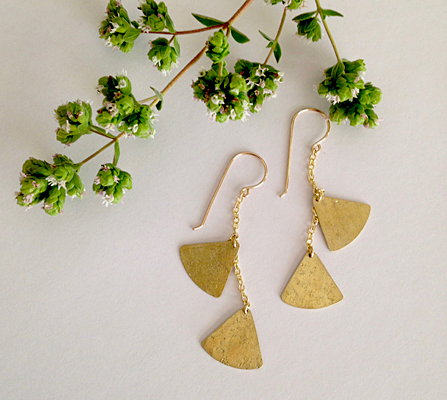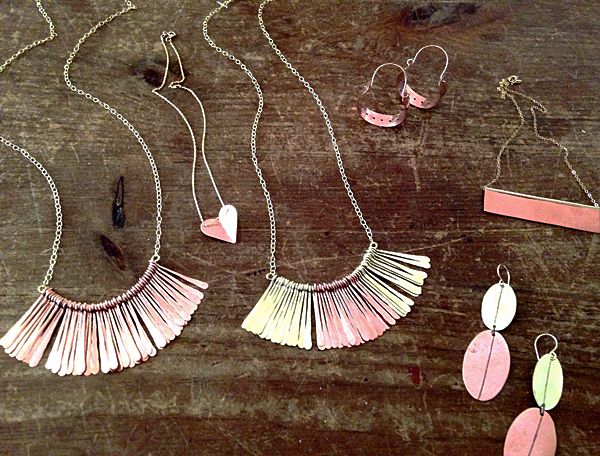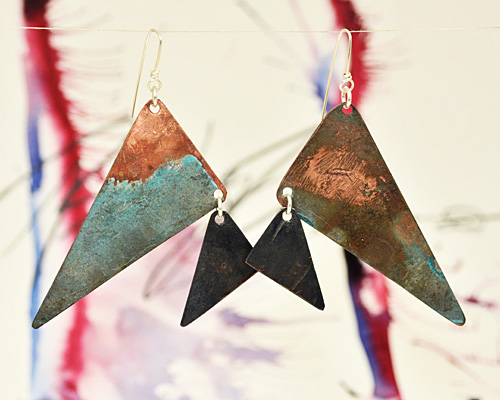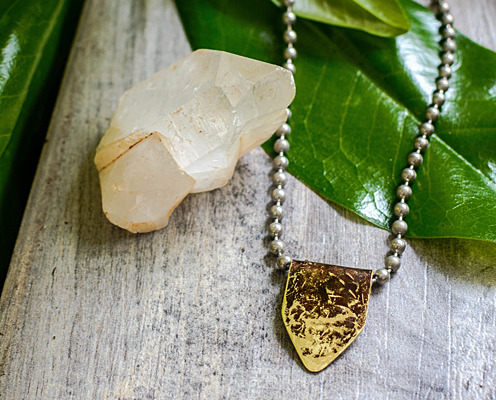The Continuing Legacy of Sustainable Jewelry
 These ginko earrings are scrap pieces of brass, texturized with concrete, fashioned through Birch: Handcrafted Wearables.
These ginko earrings are scrap pieces of brass, texturized with concrete, fashioned through Birch: Handcrafted Wearables.Photograph courtesy of Birch.
The more plentiful our world becomes, the more intelligent it is to use what’s already here—especially when it comes to reviving discarded metal. A new wave of jewelry companies are focused on creating sustainable jewelry using salvaged copper and brass that makes both fiscal and environmental sense.
Anne Kapor-Aleson operates Birch: Handcrafted Wearables, a sustainable jewelry company in Turlock, CA, is located just a little more than two hours southeast of San Francisco.
She opened the business in 2010, having always been a resourceful maker since her youngest days.
“As a little girl, I worked with bakeable clay, and I’ve always been interested in the mechanics of making things,” Kapor-Aleson says. “I’d build dollhouses out of cardboard boxes.”
Today, her jewelry pieces, many of which are copper and brass, blend as simple, elegant and minimalistic, while lightly edgy.
A good chunk of the metals she uses are ones which she inherited as salvaged materials from her grandfather on her mother's side, Jay Tanner, who worked in demolition.
Pageo Lavender Farm in her region is owned and run by her family and involves recycled barnwood and scrap metal across the property. Her father, George Kapor, Jr., runs the farm. His history of putting together buildings and tables topped with roofing material and scrap components, and his own father’s land, tended to and with concrete poured where needed, were all major influences for Kapor-Aleson.
“My dad will give me copper or zinc scrap from when he makes tabletops,” she says.
And one of her good friends who collects vintage finds goes to a lot of estate sales and flea markets, stumbling across old copper, brass, other metals and more—most of her reclaimed materials are sourced this way.
 Mixed brass and copper pieces here use reclaimed scrap copper and brass through the work of Birch: Handcrafted Wearables.
Mixed brass and copper pieces here use reclaimed scrap copper and brass through the work of Birch: Handcrafted Wearables.Photograph courtesy of Birch.
Kapor-Aleson chooses to craft sustainably made jewelry for several reasons, a few being that it’s economical but also compassionate.
“I like having a price point all around the board,” she says. “I want people to be able to afford it, and I know what it’s like to not be able to. How I see it, it’s a way to be generous and kind to others. I want people from all sectors to be able to get something they like.”
And if it weren’t about cost, Kapor-Aleson says she’d still be an advocate for reuse because of how the approach and materials are cool yet never utilized enough, compared to how prolific brand new manufacturing is across markets.
She also describes working with reclaimed materials as a part of her branding, a staple and a statement all in one, as she educates people about this subject when she’s out selling at shows—pointing out the value of using what you have.
“With reclaimed jewelry, even if I had all the money in the world, I’d still do this because it just feels good to recycle, turning junk into something pretty,” she adds. “When you’re using these kinds of materials, they’re going to have a character all of their own, which newer materials won’t have.”
Leaning into the persuasion of her personality type of having an independent mindset, not wanting to be limited by any boxed-in-thinking through pressures of the crowd at the societal level, also plays a part in this for Kapor-Aleson.
Longer and stud earrings, bracelets, cuffs and necklaces are the main kinds of jewelry she crafts.
 This set of earrings came from a copper planter given to Bobby Foxx in pieces by a confectioner in Jacksonville during an art walk; the green color is drawn out with ammonia gas, while the black comes from exposure to liver of sulfur.
This set of earrings came from a copper planter given to Bobby Foxx in pieces by a confectioner in Jacksonville during an art walk; the green color is drawn out with ammonia gas, while the black comes from exposure to liver of sulfur.Photograph courtesy of Bobby Foxx, LLC.
Recently, she’s been mixing copper with brass; the pairing of the metal and alloy across jewelry has been very well-received by customers in the San Francisco Bay area, she’s noticed.
“And brass has been so popular,” Kapor-Aleson reflects. “I enjoy brass because I like how cost-effective it is. People want that gold look, but it’s affordable. It’s easy for me to solder. You can get the look of gold without paying a fortune it.”
Bobby Foxx of Bobby Foxx, LLC in Gainesville, Florida, agrees and has seen an increase in brass-interest as well.
“Brass is an excellent substitute for gold,” Foxx says. “In fact, I believe it's been called ‘new gold.’”
Like Kapor-Aleson, Foxx has seasoned radar for locating usable materials in the natural world and has saved manufactured components for years, too.
“I was that kid with all the shells and skulls, bits of Indian pottery, feathers and rocks, climbing trees, often getting lost in the woods, missing the bus,” Foxx explains. “I created a large collection with all of those found objects from my childhood.”
Foxx is also a professional photographer and combines his sustainable jewelry work with his skills in capturing eye-scenes.
His grandmother on his mother’s side, Patricia Head, was a painter, sculptor and plumber of stained glass, always driven to work with her hands.
Her husband, Foxx’s grandfather, Robert Head, photographed for National Geographic Magazine.
“I found my grandfather’s stock photos in my textbooks more than once,” Foxx notes. “My grandparents were a big part of my life while growing up, so I was exposed to these things from an early age.”
And some of his jewelry chains are reclaimed from Venetian blinds from his other grandfather’s furniture business—that of his dad’s father, Curtis Coleman.
 The materials used for this piece are 100% upcycled. Bobby Fox uses the same technique as for his brass kickplate cuffs to render simple geometric shapes. The pendant is on a chain from Venetian blinds he inherited from his grandfather's furniture business.
The materials used for this piece are 100% upcycled. Bobby Fox uses the same technique as for his brass kickplate cuffs to render simple geometric shapes. The pendant is on a chain from Venetian blinds he inherited from his grandfather's furniture business.Photograph courtesy of Bobby Foxx, LLC.
“That's the age we live in,” Foxx says about jewelry-making in such an upcycled way today. “Precious metals are expensive, but we still have creative ideas to actualize.”
With leftover-everything in modern days, our once-owned possessions going to a landfill or becoming litter is more common—especially compared to even a century ago when far less of what’s tangible existed globally.
“There are places like The Repurpose Project here in Gainesville which specialize in getting useable materials back to artists, builders and makers,” he says. He is also a volunteer with the project.
“Also, when you start doing this sort of work, people just start giving you this stuff,” he adds. “I was given three brass kickplates [from the lower sections of doors] from a demolished building in Orlando recently and four pieces of garbage which I turned into more than 70 pieces of wearable art, unrecognizable from their previous forms.”
Earrings are Foxx's best-sellers and his favorite pieces of jewelry to make in copper. His brass cuffs and pendants develop into their slightly less typical shapes and of new surface textures through his go-to tools.
“I have a small anvil but have been known to hammer my metals on a cast-iron skillet, from time to time,” Foxx says.
A grinder, shears, pliers and Dremel-powered table press, help, too, aside from eventual tweaking of surface layers through treatment work.
And the versatility in copper is something which Foxx deeply appreciates.
“The colors I can draw out of the metal with different bases are truly astounding, and I'm always surprised when I try something new,” he says. “Just the other day, I was doing a light blue patina with ammonia, and on a whim, decided to apply some salt as it dried, and this gorgeous iron-rust-brown came out of the metal in flecks where the salt crystals landed.”
In 2014, Gainesville Fashion Week featured Foxx’s work in one of its editorials. His jewelry has been in similar shows in states like California, Kentucky and Texas, too. His jewelry has been worn by several Project Runway contestants, to boot.
“It's a reflection of me in everything I do,” Foxx says about his jewelry creations. “When I'm dead and gone, there will still be bits of metal I worked on, selfishly and stubbornly existing, telling my story. And some of the earliest artifacts were metalworks.”
Resources:
Also in this Issue:
- Harry Bertoia’s Sound Sculptures
- The Continuing Legacy of Sustainable Jewelry
- Maine Copper Studio
- Abraham Lincoln, Reimagined Through Pennies
